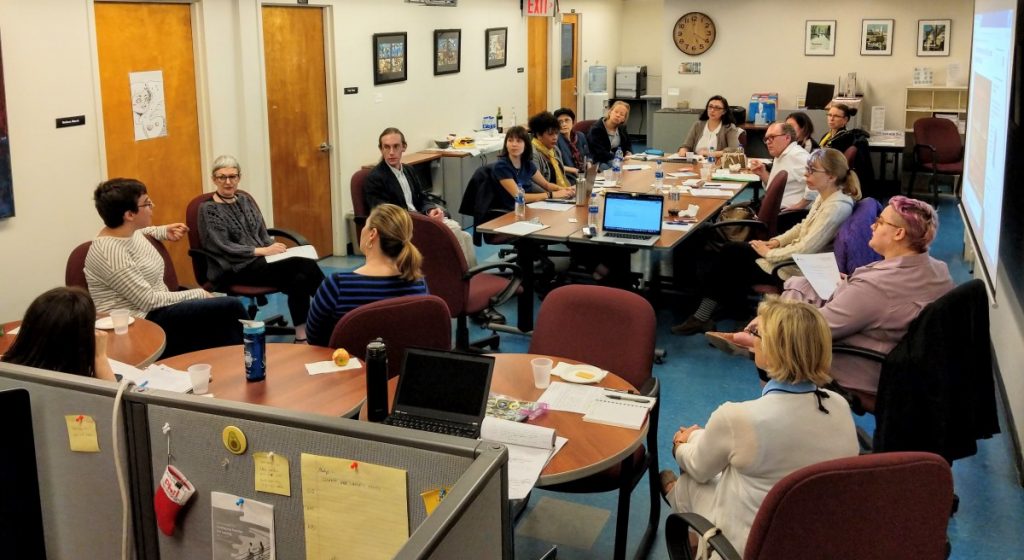On Thursday, September 19, faculty and staff from City Tech, CUNY, and other New York City universities (e.g. Pratt University) got together for the first of two Open Pedagogy events the OpenLab is hosting this semester. Participants discussed “Access Beyond the ADA”
Note that the discussion was framed around access rather than accessibility. As we noted in our post announcing the event, the term accessibility conveys the degree to which a space, process, or concept is accessible. By contrast, access denotes the process by which accessibility is achieved. Our focus on Thursday evening was on broadening our understanding of “access” beyond compliance with the ADA. We considered the following questions:
- How can open digital pedagogy impact, augment, and enhance access?
- What are the limits of technology’s impact on access and accessibility?
- What barriers to access have you encountered as faculty and staff? What about the barriers you’ve experienced students facing?
- What resources have helped you to improve access in your academic courses and projects?
Participants kicked off the evening by recounting how some of their own assumptions around access had been called into question. For example, a participant shared that once they included language in their syllabi inviting students to talk about their different learning styles, they experienced a drastic shift in their relationship with students. This faculty member noted that students had opened up to them in unexpected ways; most simply wanted to talk about how they learned and how they studied. Some were looking for advice, validation, and acknowledgement. Few were looking for technical “accommodation.” None, the faculty member emphasized, were looking for what some disparagingly call “preferential treatment.” Most students simply wanted to be heard—to have their differences recognized. This anecdote helped ground the evening in a principle that might be captured by a simple maxim: trust your students. Students are often quite aware of their needs and can tell you how to improve access to learning in your class. But they need to be given the space to do so.
Several participants echoed these experiences, including alluding to experiences of attempting to accommodate student needs and facing institutional guidelines that restrict faculty agency to grade, grant extensions, or even appropriately refer students to other offices on campus that may provide support. Even the simple awareness of which offices serve which purposes can be obfuscated to first-generation students and part-time, temporary, or contract faculty and staff, so it can be difficult to advise students on the best course of action without a thorough orientation, a luxury that seems to have diminished under austere working conditions in higher ed.
Similarly, disabled teaching and non-teaching faculty in the room recounted having to stay in the disability “closet” for much of their careers. Rare are those occasions on which university instructors are invited to share the accommodations they might require. Some noted that the use of open digital pedagogy—and platforms like the OpenLab—had made their lives much easier. The ability to create interactive and accessible web content, and to teach meaningfully through this content has been invaluable, especially for instructors with chronic illness, autism, and other disabilities that impact their ability to stand, communicate verbally or nonverbally, and other traditional pedagogical expectations in a classroom.
But significant barriers remain. The physical environment is a major obstacle to access: many participants remarked on the difficulty of getting around the CUNY campuses when disabled, remarking on simple architectural inaccessibility in the forms of steps and stairs and nonfunctional elevators, and other issues such as overcrowded hallways that can be difficult to navigate during class changes. Another barrier is that the websites students and faculty depend on—including the database search for the library—are not always easily read with a screen reader. Finally, while technology is arguable a prerequisite for improving access to learning, it can also be an auditory and visual distraction for students in the classroom. Participants noted that they sometimes struggle with what to ask their students to do with cell phones: should these be allowed on desks in class? For one math instructor, a smartphone can supplant the need for an expensive calculator as well as acting as a common means of accessing online material. But what about when they become a distraction and possibly undermine a student’s success in a course?
Finally, participants emphasized at multiple points that improvements to access must come from people—not technology. On its own, technology cannot transform a student’s learning or an instructor’s teaching or service to the university. But it can be employed with the intention of making learning affordable, accessible, and varied; it can be used to adapt teaching to different learning styles. The key word here is intention. To focus on access, participants noted, is to value the ongoing human energy that is required to meet people’s accessibility rights and, conversely, the energy people must put in to have their own rights met . The processes at play are not automatic. They have to be enacted. Our conversation last Thursday evening was one way to redouble our commitment to this enactment.
Let’s continue the conversation! Please comment on this post with thoughts/ questions. And don’t forget to join us for our next Open Pedagogy event, on November 7!




